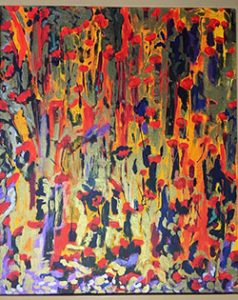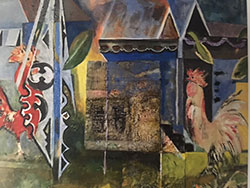
Beverly Reynolds spent the formative years of her life in a small fishing village on the island of Jamaica. In a recent interview she recalled fondly the memories of her time spent there and how she came to embrace the duality of water as one of several integral components of her creative practice.
“The sea was about fifty yards away [from us]. Towards the Christmas and hurricane season when we would get storms and the water would get choppy I would wonder if the sea would come and take [us] away.”
Despite her childhood fear regarding the potential danger of being in such close proximity to a large body of water, Reynolds would later spend a significant amount of time traversing and being inspired by Guyana’s many rivers.
“I’ve been to Kaieteur Falls and I remember seeing the Golden Frog. I’ve been to Bartica. I went there with my church on a mission one summer for about a week and we took the boat across the different islands. We also took the speedboat to Baganara Resort. Then we went into the communities where there are primarily Amerindians. I love Parika and the boats there. [Although] the colour of the water is different, the boats are still colourful and the people are colourful. The amazing thing for me is the white sand and the coloured water. My association has always been white sand and blue water. But then there’s this really white sand with the colour water that’s here. It’s very interesting.”

Although Reynolds’ knowledge of art has been acquired largely through her own self-directed efforts, her expressive brushwork, inventive techniques, vivid colour combinations and willingness to experiment with non-traditional tools and materials all suggest a thorough understanding of the principles and elements that are foundational to the process of making truly compelling work.
DH: How did you get your start in art?
BR: I didn’t do anything for a very long time. In my days we had to do what you would call a screen test or mock exam. If you didn’t get a good grade then you couldn’t sit the exam. I didn’t get a good grade so I wasn’t allowed to sit the exam. I think I went into mourning for years. In 2003, about six months or so before I came to Guyana, this burning passion came over me again. I felt like if I didn’t paint I would die. So I started doing some stuff at home. When I came to Guyana I did a lot. Most of my work, outside of what I did in high school, I did when I came to Guyana.

DH: Tell me a little bit about your decision to move here from Jamaica.
BR: If I have to be forthright and honest I would tell you that God sent me here. He told me that he had a work for me to do with the young people in the region. One day I saw an advert in the newspaper for the Global Fund and so I applied. I wasn’t selected or even shortlisted. Then about a year later I got a letter from CARICOM wanting to know if I would be interested in a position. And because I believe that God said he wanted me to work with young people in the region, I knew that was the opportunity. That was the opening. And so that’s how I came to be here.
One of my most exhilarating experiences was traveling on the Essequibo River on the big boat. It was a very peaceful journey. It was just amazing [to see] the colour of the water and the sunlight on the water. That was the time I said to myself, “I could live in this country.”
DH: How has that shift from Jamaica to Guyana changed the way you make art, if at all?
BR: I don’t think it has changed in the sense that I still use vibrant colours. But I’ve learned to appreciate the softer colours. In my more recent works [in progress] the colours are subtler and more subdued, I suppose. I don’t know that I’ll ever be able to get away from colours and I don’t know that I’d want to. I think that is just a part of me. But I’m also learning to make statements. I can make powerful statements with those subtle colours.

I’ve learned to appreciate the vastness of what I see here in Guyana. The things that grab [my attention] are the colours, the sounds, the sea and the sun. In Guyana you can’t ignore the vastness of the bodies of water. I once went to Lethem. I flew there and then I decided to come back with the bus. It took hours but that [journey] in itself was something.
DH: You spoke earlier about colour being very important to you. Is form also important or not as much? I know there aren’t very many representational figures in your work but there are references and suggestions through your brushstrokes that would suggest a body or several bodies.
BR: Sometimes a piece of canvas can have things trapped in it and as I begin to paint I see those things. So what I try to do is bring them up and out onto the canvas. There’s a shape there. There’s a story there. There’s something there. Sometimes that is what happens. Sometimes I deliberately say, “This is what I would like to do.”
 I think one of the areas I ought to work on is drawing, more so figure drawing. When I came [to Guyana] I wanted to go to the E.R. Burrowes School of Art. I had gone to check it out but my schedule didn’t allow [for enrolment]. At some point I would love to get some kind of formal training because I think there’s a lot I could learn.
I think one of the areas I ought to work on is drawing, more so figure drawing. When I came [to Guyana] I wanted to go to the E.R. Burrowes School of Art. I had gone to check it out but my schedule didn’t allow [for enrolment]. At some point I would love to get some kind of formal training because I think there’s a lot I could learn.
DH: Tell me about your approach to making marks, the way you paint and the tools you use in terms of brush, palette knife, sponge etc.?
BR: The sponge I’m only now experimenting with, I’ve never used it before. Since I’m still learning I might use a brush because I like the impression it creates. Sometimes it’s a brush that’s down to stubble but it gives me something. Sometimes instead of dabbing the paint it might just do etchings and that comes out with an interesting effect. Sometimes I would try something and if it doesn’t work then I would erase it and start again. There’s one that I’ve been painting for almost the 13 years I’ve been here. It’s still not finished yet and I don’t know if I will finish it. Then there are others that I would paint for two or three hours steady and when I’m finished I feel like there’s nothing else I can do. If I do something else to it then I would’ve wrecked it. There are times when I’ve totally changed a painting. So I have photographs of paintings that no longer exist because I changed them.
DH: How do you balance what you do professionally with your artistic practice?
 BR: That is hard because it’s a very demanding area of work that I’m engaged in. So my tendency is to work on weekends. There was a time when I couldn’t even do that because my workload was that heavy. I’ve worked at night using fluorescent light and all kinds of things shining. But my preference is really to have daylight in which to work, and to work when I have a reasonable expanse of time. Now I’m trying to bring back that balance by working late so that I have the weekends free.
BR: That is hard because it’s a very demanding area of work that I’m engaged in. So my tendency is to work on weekends. There was a time when I couldn’t even do that because my workload was that heavy. I’ve worked at night using fluorescent light and all kinds of things shining. But my preference is really to have daylight in which to work, and to work when I have a reasonable expanse of time. Now I’m trying to bring back that balance by working late so that I have the weekends free.
DH: What are you working on right now?
BR: In 2010 my sister and I along with a colleague and a friend went on a European tour to Italy, Spain, Greece and Turkey. Santorini (Greece) was one of the most memorable parts of the journey. Now I’m actually working on my take on Santorini and what it looks like. They talk about the colour Mediterranean Blue but you have to see it. It is beautiful.
Beverly Reynolds is the Coordinator of the Health and Human Development department at the CARICOM Secretariat. Since moving to Guyana in 2003 she has exhibited at the Caribbean Festival of the Arts (CARIFESTA) in Suriname. Reynolds has also shown work in a number of exhibitions including CARIFESTA (Guyana) in 2008; the annual exhibitions of the Guyana Women Artists Association (2004 to present); and the Annual Staff Talent Exhibition at the CARICOM Secretariat (2003 to present).



.jpg)











